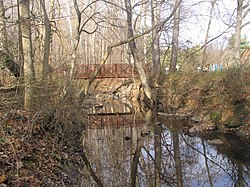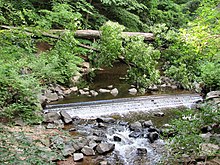Sligo Creek
| Sligo Creek | |
|---|---|
 The creek running through Silver Spring, Maryland | |
 Map of the Anacostia River watershed showing Sligo Creek | |
| Location | |
| Country | United States |
| State | Maryland |
| City | Silver Spring, Maryland |
| Physical characteristics | |
| Source | |
| • location | Kemp Mill, Maryland |
| • elevation | 450 ft (140 m) |
| Mouth | Northwest Branch |
• location | Hyattsville, Maryland |
• coordinates | 38°57′32″N76°58′26″W/ 38.959°N 76.974°W |
• elevation | 35 ft (11 m) |
| Length | 9.1 mi (14.6 km) |
| Basin size | 11.6 sq mi (30 km2) |
| Discharge | |
| • location | Takoma Park |
| • average | 26 cu ft/s (0.74 m3/s) |
| • minimum | 3.3 cu ft/s (0.093 m3/s) |
| • maximum | 49 cu ft/s (1.4 m3/s) |
| Basin features | |
| Tributaries | |
| • left | Long Branch |
| • right | Wheaton Br, Comstock Br, Takoma Park Br |
Sligo Creekis a free-flowingtributaryof theNorthwest Branchof theAnacostia RiverinMaryland.(The Anacostia, in turn, feeds into thePotomac Riverand eventually empties into theAtlantic OceanviaChesapeake Bay.) Thecreekis approximately 9.1 miles (14.6 km) long,[1]with adrainage areaof about 11.6 square miles (30 km2).
Geography[edit]
The creek rises in theKemp Millsection ofSilver SpringinMontgomery Countyand joins with Northwest Branch near the city ofHyattsvilleinPrince George's County.The lower portion of the creek has beenchannelized.Elevationsin the subwatershed range from 450 feet (137 m) abovesea levelto 35 feet (11 m) at theconfluencewith Northwest Branch; the averagegradientfor the course of the creek is 0.72%.
Contributing streams that flow into the creek include Wheaton Branch, Comstock Branch, Takoma Park Branch, and Long Branch.
Sligo Creek is one of the most heavilyurbanizedsubwatersheds in the Anacostiawatershed,with a population density of 7,081 people per mi2.75% of the watershed is in Montgomery County, 20% is in Prince George's County, and 5% is in theDistrict of Columbia.Less than 15% of the subwatershed is undeveloped, and only 10% is forested. Less than 0.01% of the area iswetlands.[2]
From its source to the confluence with the Northwest Branch, the creek crosses through the communities ofSilver Spring,Wheaton,Takoma Park,Carole Highlands,ChillumandHyattsville.In these towns, the banks of the creek are in many stretches maintained as public parkland, with grassy lawns and playing fields.
TheSligo Creek Trail,a hiker-biker trail, runs along the creek from Wheaton to the confluence, where it connects with theAnacostia Tributary Trail System.Anautomobile parkwayruns along many parts of the creek in Montgomery County.
Pollution and stream restoration[edit]

The Sligo Creekwatershedis a highly urbanized area, and as a result thewater qualityin the creek and tributaries is degraded. In 2002 theMaryland Department of the Environment(MDE) classified the creek as having poor water quality. The Montgomery County Government began installing severalstormwater managementandstream restorationprojects in the watershed in 1989, and by 2009 MDE had recognized some improvements in stream quality.[3]Additional county projects are ongoing as of 2018.[4]
History[edit]
Sligo Creek was named after the crossroads named "Sligo" founded in the mid 19th century byIrish immigrantworkers on theC&O Canal.It may have been named afterCounty Sligoin Ireland. The crossroads was located at Colesville Road and the7th Street Pike,currently the corner of Colesville Road andGeorgia Avenuein Silver Spring. At the time of theCivil War,Sligo had a toll gate on the 7th Street Pike, an inn and a post office. A half mile from the Sligo crossroads Colesville Road crosses Sligo Creek.[citation needed]NOTE: "SLEGOE" was the name of a part of the tract of land titled "Charles and William" lying in the encompassed area that became the Village of SLIGO, owned by the BEALL, BADEN and CLARK families. First mention of and identified as "SLEGOE" is found in 17th and 18th century Land Records recorded in Prince George's County and later, Montgomery County, Maryland.
Over the years, Sligo Creek has served many purposes for area residents, including powering grist mills and as adrinking watersource. In the Takoma Park section of the creek (nearWashington Adventist University), the remains of a dam and associated building foundations for the Sligo Creek Waterworks can still be seen. From 1900 to 1930, thewaterworks,the earliest public water system in the area, served the city of Takoma Park. The water system was sold to theWashington Suburban Sanitary Commissionin 1919, which abandoned the facility in 1930.[5]
Another dam, located where Flower Avenue crosses Sligo Creek, served Sligo Mill which was located where the currentNew Hampshire Avenuecrosses Sligo Creek. Sligo Mill was built in 1812 by investors that included several members of the prominent MarylandCarroll family.In addition to milling grain for local farmers, Sligo Mill distilledwhiskey.The mill was demolished in the 1920s.
Overlooking the dam and millpond for Sligo Mill on the right bank of Sligo Creek, the Glen Sligo Hotel and Wildwood Amusement Park were built in 1900. The hotel and amusement park ceased operations in 1903.[6][7]
Sligo Creek served as the inspiration and title for "Sligo River Blues", a song byTakoma ParkguitaristJohn Fahey,who popularized the area amongst folk artists.[8]It also inspired "Sligo Creek," an Irish traditional reel composed by an American banjo, mandolin, fiddle and guitar player Danny Noveck, who lived near the creek at the time he composed the melody.[9]Another prominent folk guitarist,Al Petteway,composed "Sligo Creek" while living in the Takoma Park area. This Scots-influenced guitar tune was later featured as the theme song ofThe National Parks,a PBS miniseries directed byKen Burns.[10]
The creek, where her son and his friends played as children, was part of the inspiration forKatherine Paterson'sNewbery Medalaward-winning bookBridge to Terabithia.[11]
See also[edit]
External links[edit]
- "Sligo Creek - Watershed Assessment".Montgomery County Department of Environmental Protection. Archived fromthe originalon 2012-03-10.
- "Friends of Sligo Creek".
- "Current Conditions for Sligo Creek near Takoma Park, MD".USGS Station ID 01650800 Protection.Retrieved2012-05-07.
- EyeOnSligoCreek—independent multimedia website covering Sligo Creek and the rest of the Anacostia River Tributary Trail System.
References[edit]
- ^ "National Hydrography Dataset high-resolution flowline data".The national map.U.S. Geological Survey.RetrievedAugust 15,2011.
- ^"sligo Creek: Profile".Anacostia Watershed Restoration Partnership.Retrieved2009-08-31.
- ^"Stream Restoration Reduces Peak Storm Flow and Improves Aquatic Life in Sligo Creek"(PDF).Polluted Runoff: Nonpoint Source Pollution.Washington, D.C.: U.S. Environmental Protection Agency. May 2012. EPA 841-F-12-001J.
- ^"Restoration Projects".Watershed Restoration.Rockville, MD: Montgomery County Department of Environmental Protection.Retrieved2018-06-23.
- ^Dwyer, Micahel F. (June 2, 1975).Inventory of Historical Sites Survey Waterworks Site-Sligo Creek(PDF)(Report). Maryland Historical Trust.Retrieved2020-07-16.
- ^"Fabulous Glen Sligo Hotel Spices Early Takoma History".The Takoma Journal.1950-06-30.
- ^"The Closing of the Wildwood Poolroom at the Glen Sligo Hotel".The Washington Post.1903–1904.
- ^"John Fahey and the 'Sligo River Blues'".Friends of Sligo Creek.Retrieved2012-05-07.
- ^Cavanagh, Patrick (June 8, 2007)."Sligo Creek reel (comment)".The Session.Retrieved2020-07-16.
- ^"The Music".The National Parks: America's Best Idea.WETA-TV.Retrieved2019-01-29.
- ^Kline, Sally (February 15, 2007)."From Takoma to Terabithia".Washington Examiner.Washington, D.C.Retrieved2020-07-16.
